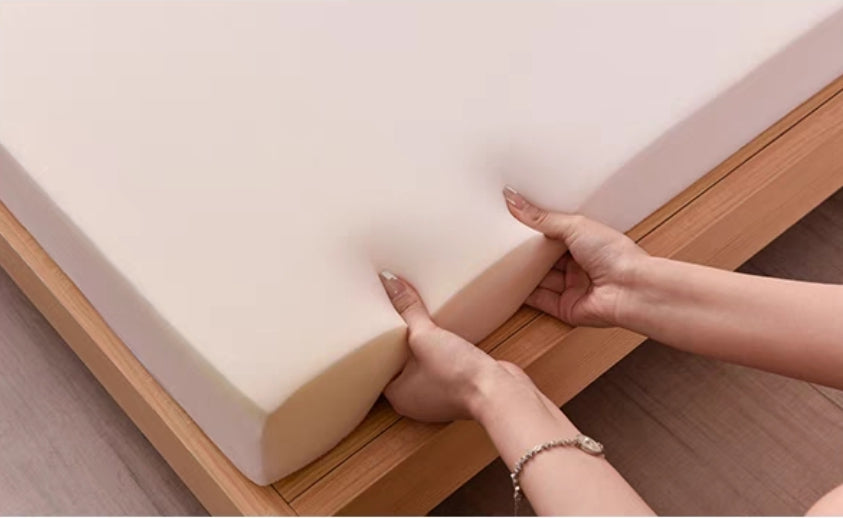Eco mattress

Eco mattress
10 Signs It's Time to Replace Your Mattress
on Feb 26 2025
Your mattress plays a crucial role in your health and well-being. It affects the quality of your sleep, your mood, and even your posture. But like all things, mattresses don’t last forever. Over time, they begin to lose their comfort, support, and durability, leading to poor sleep quality and even health problems. But how can you tell when it’s time to replace your mattress?
In this article, we’ll explore 10 signs that it's time to replace your mattress, the importance of doing so, and tips on choosing a new mattress that will give you the restful sleep you deserve.
1. You Wake Up with Aches and Pains
One of the most obvious signs that it’s time for a new mattress is waking up with persistent aches and pains. If you find yourself experiencing back, neck, or shoulder pain in the morning that gradually fades throughout the day, your mattress might no longer be providing the necessary support.
Over time, mattresses lose their ability to support your spine and joints properly. If your mattress is sagging or has become uneven, it can put extra pressure on certain areas of your body, leading to pain. If you notice pain or discomfort that worsens over time, it’s probably time to replace your mattress.
2. You Notice Sagging or Visible Indentations
Take a closer look at your mattress. Do you notice any visible sagging or indentations where you sleep? A sagging mattress is a sure sign that the support system inside the mattress has broken down. These dips can create uneven pressure points and can result in a restless night’s sleep.
If you see noticeable sagging in the middle or at the edges, it’s time to consider replacing your mattress. Ideally, your mattress should maintain a uniform surface that supports your body evenly.
3. Your Mattress Is Over 7-10 Years Old
Even the best mattresses wear out after time. Most mattresses typically last between 7 to 10 years. The materials break down, the springs lose their elasticity, and the foam becomes compressed. If your mattress is over 7 years old, it’s worth considering a replacement, especially if you’ve noticed other signs of wear and tear.
If you don’t know the age of your mattress, look for a tag or label that provides manufacturing details. If it’s older than 7 years, your mattress may no longer provide the support and comfort you need.
4. You’re Frequently Waking Up During the Night
Do you frequently wake up in the middle of the night, tossing and turning? If you’re experiencing poor sleep quality and find yourself constantly waking up, it may be a sign that your mattress is no longer providing the comfort it once did.
A mattress that doesn’t allow you to sleep soundly through the night might be due to discomfort caused by sagging or an imbalanced sleep surface. This can disrupt your sleep cycles, leading to fatigue, irritability, and poor performance the next day.
5. You Experience Allergies or Breathing Issues
Mattresses can collect dust mites, allergens, and bacteria over time, which can lead to allergic reactions or worsen breathing issues. If you’re noticing symptoms such as sneezing, coughing, or stuffy nose, and you haven’t experienced these symptoms before, it could be due to allergens trapped in your old mattress.
Replacing your mattress can significantly reduce allergens and improve your indoor air quality. Opt for a mattress with hypoallergenic materials if you’re particularly sensitive to dust or allergens.
6. You Notice That Your Mattress Smells
Over time, mattresses can absorb moisture, sweat, and even body oils. This leads to unpleasant smells that are hard to get rid of. If you notice that your mattress smells musty, damp, or unpleasant despite regular cleaning, it could be a sign that bacteria, mold, or mildew have developed.
If the smell doesn’t disappear after proper cleaning, it may be a sign that the mattress has reached the end of its lifespan and is time to be replaced.
7. You Can Feel the Springs or Coils
If you start feeling the springs or coils poking through the mattress as you lie down, it’s time for a new one. Over time, the internal support system of the mattress can break down, and the coils can lose their elasticity. This can lead to uncomfortable pressure points, disrupting your sleep.
Feeling the springs or coils is an obvious sign that the mattress is no longer providing the right level of support and comfort.
8. Your Mattress Makes Noise
A creaky mattress isn’t just annoying—it’s also a sign that it’s time to replace it. If you notice that your mattress makes squeaking, creaking, or popping sounds every time you move, it’s likely a sign that the springs or coils inside are worn out.
Noisy mattresses indicate that the support system is no longer working properly. If your mattress is making noise, it’s a good idea to start shopping for a replacement.
9. You’re Not Sleeping as Well as You Used To
If you’ve noticed a steady decline in the quality of your sleep, it might be due to your mattress. Even though you might be spending the same amount of time in bed, your mattress may no longer be providing the comfort or support you need to fall into a deep, restorative sleep.
A mattress that’s too soft or too firm can lead to uncomfortable sleeping positions, which affect your ability to get a good night’s rest. If you’re constantly waking up feeling tired, it’s worth considering replacing your mattress.
10. Your Partner Complains About Disturbing Movements
Do you share your bed with a partner and notice that movements disturb your sleep? If your mattress is old or worn, it might not have the ability to isolate movement properly. This means that every time your partner moves, it can wake you up, leading to a restless night.
Modern mattresses, particularly memory foam and hybrid mattresses, are designed to reduce motion transfer. If your current mattress is disturbing your partner’s sleep (or vice versa), it’s time for an upgrade.
Why It’s Important to Replace Your Mattress
Replacing your mattress is not just about comfort—it’s about your overall health. Sleeping on a mattress that no longer supports you can lead to:
Chronic pain in your back, neck, and joints
Disrupted sleep patterns, leading to fatigue and irritability
Increased risk of allergies or respiratory issues
Poor posture, which can result in long-term health problems
Investing in a new mattress is investing in your health. By replacing your mattress when it shows signs of wear, you’ll improve your sleep quality, reduce pain, and wake up feeling refreshed every morning.
How to Choose a New Mattress
When it’s time to replace your mattress, selecting the right one can be a bit overwhelming given the wide variety of options. Here are a few tips to help you choose the right mattress for your needs:
Consider Your Sleep Position: If you're a side sleeper, a softer mattress may be better for providing pressure relief. For back or stomach sleepers, a firmer mattress will support spinal alignment.
Look for Quality Materials: Consider memory foam for contouring support, innerspring for bounce and support, or hybrid for a combination of both.
Test Before You Buy: Many mattress retailers offer trial periods so you can test out a mattress at home. Take advantage of this and make sure it’s comfortable for you.
Check the Warranty: A good mattress should come with a solid warranty, often 10 years or more, to ensure you're covered if there are any manufacturing defects.
Conclusion
A good night’s sleep is vital for your health and happiness, and your mattress plays a major role in that. If you’re experiencing any of the 10 signs mentioned above, it may be time to invest in a new mattress. Don’t wait until your old mattress causes health problems or keeps you up at night. Replace it with one that supports your body and helps you get the restorative sleep you need.
Choosing the right mattress doesn’t have to be difficult. By understanding your preferences, sleep habits, and needs, you’ll be able to find a mattress that suits you perfectly and improves your sleep quality for years to come.

Eco mattress
What Is the Difference Between GRAY and OCEAN?
on Feb 26 2025
Ablyea mattresses have earned a great reputation for their high quality and affordability, attracting many satisfied customers. However, first-time visitors to our website often wonder: What’s the difference between the GRAY and OCEAN models? The truth is, there’s not a huge difference—mostly just variations in design.
What Do GRAY and OCEAN Have in Common?
Service:
Both mattresses come with free shipping, a lifetime warranty, and a 365-night trial. This allows customers to shop worry-free—if you don’t love the mattress, you can return it. If you encounter any issues, our dedicated customer support team will assist with repairs or replacements.
Firmness:
Both models offer a medium firmness, providing the perfect balance of comfort and support—making it one of the most popular firmness levels on the market. However, we understand that everyone has a unique preference when it comes to softness and firmness. That’s why both models come in different thickness options:
Prefer a firmer feel? Choose the 10” version.
Looking for extra plushness? Go for the 14” version.
Individually Wrapped Coils:
Both mattresses feature individually wrapped coil springs, which are superior to traditional interconnected coils. Because each coil is separately wrapped, these mattresses minimize noise and motion transfer—perfect for couples where one partner tends to toss and turn or get up at night.
Certifications:
Both the GRAY and OCEAN models are CertiPUR-US and OEKO-TEX certified, ensuring they are completely safe and free from harmful chemicals. Additionally, our mattresses contain no fiberglass, prioritizing your health and well-being.
Pressure Relief:
With an 8-layer construction, these mattresses include a pressure-relieving comfort layer made from high-quality gel-infused memory foam. This layer contours to your body, providing optimal support and pressure relief for a restful night’s sleep.
What’s Different Between GRAY and OCEAN?
The key difference lies in design and convenience:
OCEAN features built-in side handles, making it easier to rotate the mattress.
Aesthetic preferences:
OCEAN is designed to complement modern, minimalist bedroom styles.
GRAY is better suited for classic or vintage-inspired decor.
Ultimately, the choice comes down to your personal style preference—both models deliver the same outstanding comfort and quality!

Eco mattress
What Is the Best Material for a Mattress?
on Aug 27 2024
There are many types of mattress materials, each with unique advantages and applications. Here’s an overview of the main options:
Innerspring
Memory foam
Gel memory foam
Polyfoam
Latex
Hybrid
Air bed
Water bed
What is a innerspring mattress?
Innerspring mattresses are considered the "classic" option. Their history dates back to the late 19th century. Innerspring mattresses offer excellent support and durability and have grown in popularity over the years. Early Bonnell springs were one-piece and interconnected, providing good support but with issues like significant motion transfer and noise under pressure, which can be disruptive for couples.
However, the development of individually pocketed coils has addressed these issues. Each coil can move independently, reducing motion transfer and noise, making these mattresses quieter and more adaptable to body curves.
What are the pros and cons of innerspring mattresses?
Pros:
Strong support: Innerspring mattresses provide firm support and are especially suitable for those needing extra back support.
Good ventilation: They have gaps that allow air circulation, keeping the mattress dry and cool—ideal for people who get hot while sleeping.
Great value: Generally more affordable than memory foam, making them a good option for budget-conscious consumers.
Durability: High-quality innerspring mattresses can last many years.
Cons:
Motion transfer: One-piece innerspring mattresses can have more motion transfer between partners, potentially affecting sleep quality.
Possible noise: Over time, they may produce noise due to wear and tear on the springs.
Limited edge support: Some models may lack strong edge support, causing the edges to sag.
What is a memory foam mattress?
Memory foam, originally developed for airplane seats in the 1960s, is known for its slow rebound properties, which allow it to absorb impact. It’s popular for its comfort and motion isolation but is not water-resistant. It’s best to use a waterproof mattress protector with memory foam.
What are the pros and cons of memory foam mattresses?
Pros:
Pressure relief: Memory foam evenly distributes body weight and relieves pressure points, contouring to the body's curves and offering a cloud-like feel—especially beneficial for joint issues.
Motion isolation: It reduces motion transfer, making it ideal for couples who want a quieter sleeping environment.
Cons:
Heat retention: Traditional memory foam can retain heat, leading to a warmer sleeping experience.
Slow rebound: The foam’s slow rebound can make turning over feel sluggish.
Odor: New memory foam mattresses may emit a slight chemical smell that needs time to dissipate.
What is a gel memory foam mattress?
Gel memory foam is an advanced version of memory foam designed to address heat retention issues. It incorporates gel particles or layers to improve breathability and temperature regulation but is often more expensive.
What are the pros and cons of gel memory foam mattresses?
Pros:
Temperature regulation: Gel particles help absorb and disperse body heat, offering a cooler sleep experience.
Pressure relief: It evenly distributes body weight and alleviates pressure points.
Motion isolation: It effectively reduces motion transfer, making it suitable for couples.
Cons:
Increased weight: The addition of gel may make the mattress heavier and harder to move.
Possible unevenness: Low-quality gel memory foam may have uneven gel distribution, leading to uneven support.
Higher price: It is generally more expensive than traditional memory foam.
What is a foam mattress?
Foam mattresses, often made from polyurethane, are versatile and affordable. They come in various densities and hardnesses, which can be customized to different needs.
What are the pros and cons of foam mattresses?
Pros:
Variety: Foam mattresses offer various density and firmness options to meet different comfort needs.
Affordable: Generally less expensive than other types, making them a good budget option.
Lightweight: Easier to move due to their lighter weight.
Cons:
Less breathable: Foam mattresses are less breathable compared to latex or hybrid options, potentially leading to overheating.
Limited support: Low-density foam may lack adequate support and have a shorter lifespan.
Easily warped: Low-quality foam can dent and warp with heavy use.
What is a latex mattress?
Latex, derived from the sap of the rubber tree, is known for its comfort, elasticity, and natural antibacterial properties. It comes in natural and synthetic forms. Natural latex offers better breathability and elasticity, while synthetic latex is more durable and affordable.
What are the pros and cons of latex mattresses?
Pros:
High elasticity: Offers excellent elasticity, strong support, and comfort, suitable for various sleeping positions.
Natural antibacterial and anti-mite: Resists bacteria and dust mites, making it suitable for allergy sufferers.
Good breathability: The open cell structure helps keep the mattress cool and dry.
Cons:
Higher price: Natural latex mattresses can be expensive.
Heavier: Generally heavy and challenging to move.
Possible odor: Some latex mattresses may have a slight rubbery smell when new, which dissipates over time.
After reviewing the pros and cons of different materials, you might wonder if there’s a perfect mattress. The answer is yes! Hybrid Mattresses combine the benefits of multiple materials. Typically, they consist of a spring support system (such as individually pocketed springs) and comfort layers (like memory foam, gel memory foam, or latex).
What are the pros and cons of hybrid mattresses?
Pros:
Good support and comfort: Combines springs and foam for excellent support and comfort. The spring system supports the body, while foam or latex layers relieve pressure and improve spinal alignment.
Motion isolation: Individually wrapped coils allow each spring to move independently, reducing motion transfer and minimizing sleep disturbances.
Suitable for various sleeping positions: Adapts well to different sleeping positions, offering the right support and comfort whether you sleep on your side, back, or stomach.
Better air circulation: The spring system promotes airflow, helping to regulate temperature and keep the mattress cool, which is beneficial for those who sweat during sleep.
Variety of options: Offers many material and layer combinations to suit different preferences and needs.
Mattress materials to avoid: Fiberglass
Fiberglass, made from tiny glass strands, is used in some mattress interlayers. If not properly sealed, fiberglass can leak through the fabric, causing irritation, itching, and rashes. Inhalation can irritate the respiratory tract, leading to symptoms like sore throat, cough, and shortness of breath. It’s also a carcinogen. To avoid this, look for mattresses with CertiPUR-US certification to ensure material safety.
How to choose the right mattress type? Consider the following:
Comfort: Choose a mattress that aligns with your sleep habits and preferences to ensure comfort and relaxation in any position.
Support: Select a mattress that supports natural spinal alignment based on your physical condition. For back pain, consider hybrid or latex options.
Durability: Opt for reliable materials and brands to ensure longevity and consistent performance.
Heat dissipation: For better temperature control, choose a mattress with good breathability, such as latex, hybrid, or memory foam with cooling gel.
Motion isolation: If sharing a bed, consider mattresses with good motion isolation, like hybrids with memory foam or gel memory foam, to minimize disturbances.
Budget: Balance your needs with your budget. High-quality mattresses can be costly, but many affordable options offer good value.
We spend about a third of our lives in bed, so selecting the right mattress is crucial for ensuring good sleep and overall health.
Good night!
